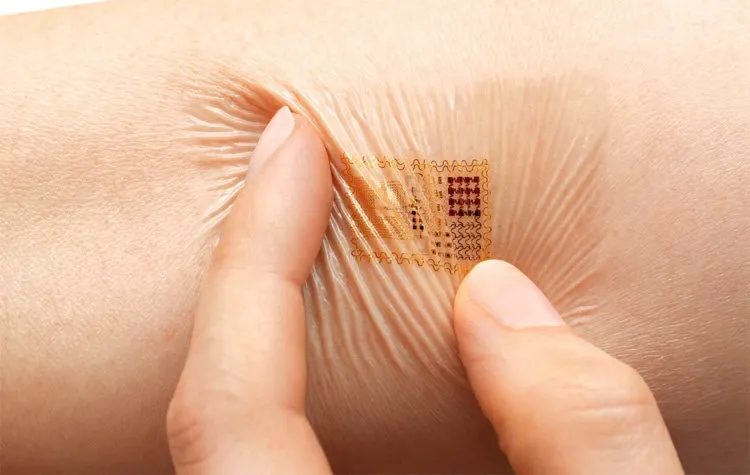Key Points
- Epidermal electronics are ultra-thin, skin-like wearable devices designed for seamless health monitoring.
- They address gaps in accuracy, comfort, and continuous data tracking left by traditional wearables.
- Applications include chronic symptom management, rehabilitation, stress and sleep monitoring, and personalized medicine.
- Regulatory, privacy, and adoption challenges remain, but the market outlook is strong.
- Future growth depends on affordability, user trust, and healthcare system integration.
A Glimpse Into the Future of Wearables
What if your skin itself became the most advanced health sensor you could own? Imagine a patch as thin as a temporary tattoo that could track hydration, monitor heart palpitations, or even measure stress—without bulky gadgets or frequent recharging. That future is no longer confined to science fiction; it is emerging in the form of epidermal electronics, the next leap in wearable technology.
These skin-like devices represent more than an upgrade from smartwatches or fitness trackers. They promise a deeper integration between human biology and digital health systems, opening new doors for preventive care, chronic symptom management, and personalized therapy. Researchers see them as part of a larger shift toward continuous, real-time health insights that could eventually transform how healthcare is delivered [1].
Why Epidermal Electronics Matter in Healthcare
Traditional wearables have already proven valuable, but their bulk and design make them less than ideal for 24/7 use. For users managing blood sugar regulation problems, heart problems, or chronic tiredness, accurate and continuous monitoring can mean the difference between early intervention and a missed warning sign.
Epidermal electronics matter because they overcome barriers to comfort and accuracy. Their thin, flexible design allows users to wear them for days without noticing, making data collection more reliable. This matters not only for health-conscious individuals but also for health professionals seeking consistent information to guide therapy decisions [2]. By offering the possibility of hospital-level monitoring outside the clinic, they could help reduce costs, improve user outcomes, and expand access to care.
From Bulky Devices to Skin-Like Precision
Challenges Traditional Wearables Face
Despite their popularity, today’s wearables often fall short. Devices strapped to wrists or clipped to clothing may shift during activity, leading to unreliable readings. Battery life remains a frequent frustration, especially for those who need continuous monitoring. For many users, the feeling of “wearing a device” creates fatigue, making long-term use impractical.
How Epidermal Electronics Fill the Gap
Epidermal electronics are designed to mimic the skin’s stretch and feel, solving these limitations. Built with ultrathin silicon membranes and flexible conductors, they can bend and move with the body without losing accuracy. Unlike conventional wearables, they form an almost invisible interface with the skin, enabling high-fidelity tracking of vital signs, hydration levels, or muscle activity in real time [3].
The Science of Skin-Like Devices
The innovation lies in materials engineering. Researchers use bio-compatible polymers, nanomaterials, and microfluidics to build patches that are soft yet durable. These devices often resemble clear stickers but contain advanced sensors capable of transmitting data wirelessly.
What makes them especially powerful is their ability to capture subtle signals with precision. For example, they can measure sweat composition to assess hydration, detect electrical signals from muscles during rehabilitation, or track fluctuations in skin temperature that indicate stress or infection risk [4]. Early studies suggest that these devices can perform with accuracy comparable to hospital-grade machines, but in a form factor that is almost invisible to the user [5].
Transformative Applications in Everyday Health
Epidermal electronics are already showing potential across a wide spectrum of health applications:
- Chronic Symptom Monitoring: Continuous tracking of heart palpitations or blood sugar regulation problems can alert users and health professionals to dangerous trends before they escalate.
- Rehabilitation Support: By monitoring muscle signals during recovery, these devices provide detailed feedback that can improve therapy outcomes.
- Sleep and Stress Insights: Subtle changes in skin conductance and heart rate variability can reveal patterns linked to sleep problems or anxious thoughts, helping users adopt healthier habits.
- Personalized Therapies: Instead of occasional checkups, epidermal patches allow health professionals to adjust therapies in real time, based on ongoing data [6].
Market Outlook and Industry Momentum
The wearable device market is already booming, and epidermal electronics are seen as the “next big wave.” Market analysts predict that the global sector for skin-like devices could reach billions within the next decade as healthcare systems shift toward continuous, at-home monitoring [7].
Startups, universities, and major tech companies are investing heavily in the field. For example, research teams have developed patches capable of tracking glucose levels without needles, while others are piloting hydration monitors for athletes. The convergence of miniaturized electronics, wireless connectivity, and growing demand for personalized care is accelerating adoption.
Privacy, Regulation, and the Question of Trust
With every new stream of health data comes the challenge of protecting it. Epidermal electronics will generate continuous records of highly personal information, raising concerns about ownership and privacy.
Regulators are working to establish standards for safety, accuracy, and data security. At the same time, ethical debates are growing around how insurers, employers, or even sports organizations might use this intimate data [8]. Building user trust will be critical—without strong safeguards, adoption could stall despite the technology’s promise.
Barriers to Adoption and Future Potential
While the science is compelling, several barriers remain:
- Cost: Production at scale must become affordable for wide adoption.
- Durability: Long-term wearability under daily stresses like sweat and movement still needs improvement.
- Awareness: Many users remain unaware of these devices or hesitant to trust them with sensitive data.
Experts believe that as costs decline and privacy frameworks mature, epidermal electronics could become as common as adhesive bandages—discreet, accessible, and trusted as part of everyday health management.
Real-World Glimpses of Progress
Early pilot studies already highlight real-world potential. In sports, athletes have used epidermal hydration patches to prevent dehydration during high-intensity training. In healthcare, users with heart palpitations have reported the comfort of continuous monitoring without the discomfort of traditional electrodes [5]. These glimpses provide a preview of how seamlessly integrated, skin-like devices might redefine the user experience.
Moving Forward: What Readers Can Do Today
Epidermal electronics are still in their early stages, but innovation is advancing quickly. Readers can:
- Stay informed by following university research labs and technology conferences.
- Ask health professionals about emerging monitoring solutions.
- Consider how seamless, skin-like wearables might fit into their own wellness routines in the near future.
As the line between biology and technology blurs, the promise of epidermal electronics suggests a future where monitoring health may one day feel as natural as wearing your own skin.
The article does not in any way constitute as medical advice. Please seek consultation with a licensed medical professional before starting any treatment. This website may receive commissions from the links or products mentioned in this article.
Subscribe for Free for more insightful health articles tailored to your needs.
Sources
- Rogers, J. A., et al. (2019). Epidermal electronics for continuous healthcare monitoring. Nature Reviews Materials. https://doi.org/10.1038/s41578-019-0092-9
- Trung, T. Q., & Lee, N. E. (2016). Flexible and stretchable physical sensor integrated platforms for wearable human-activity monitoring and personal healthcare. Advanced Materials. https://doi.org/10.1002/adma.201504244
- Kim, D. H., et al. (2011). Epidermal electronics. Science. https://doi.org/10.1126/science.1197554
- Bandodkar, A. J., et al. (2019). Wearable bioelectronics for sweat analysis. Nature Electronics. https://doi.org/10.1038/s41928-019-0210-4
- Huang, X., et al. (2014). Materials and designs for epidermal bioelectronics. Applied Physics Reviews. https://doi.org/10.1063/1.4895780
- Xu, S., et al. (2014). Soft microfluidic systems for wearable bioelectronics. Science Translational Medicine. https://doi.org/10.1126/scitranslmed.3010495
- MarketsandMarkets. (2023). Wearable medical devices market forecast report. https://www.marketsandmarkets.com
- U.S. Food and Drug Administration. (2022). Digital health technologies: FDA regulation and guidance. https://www.fda.gov




